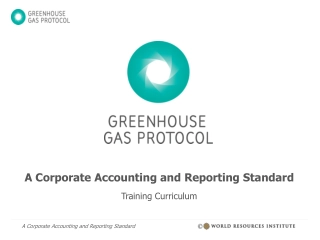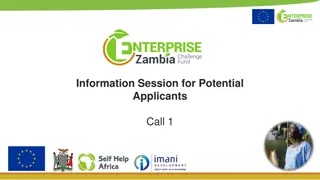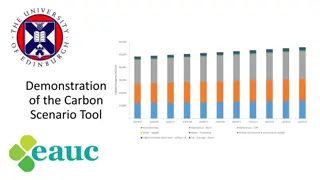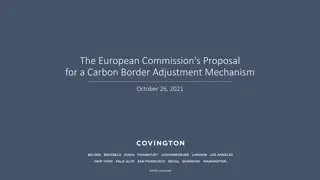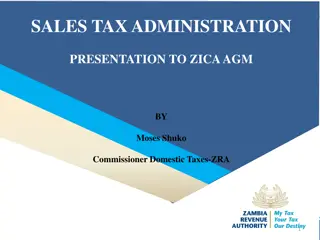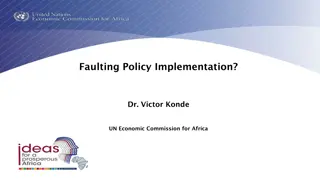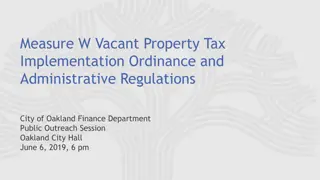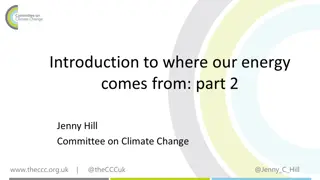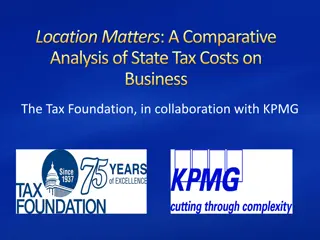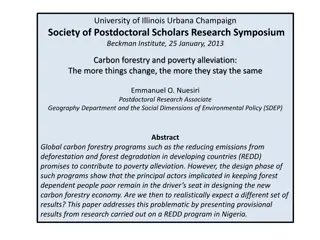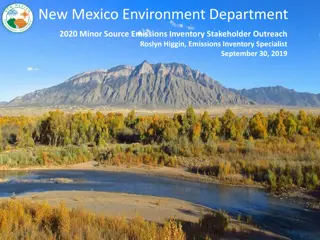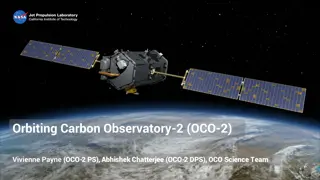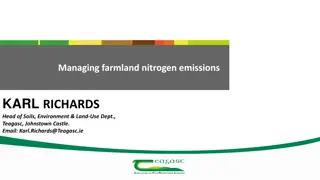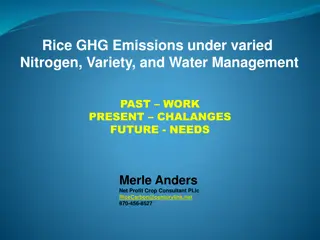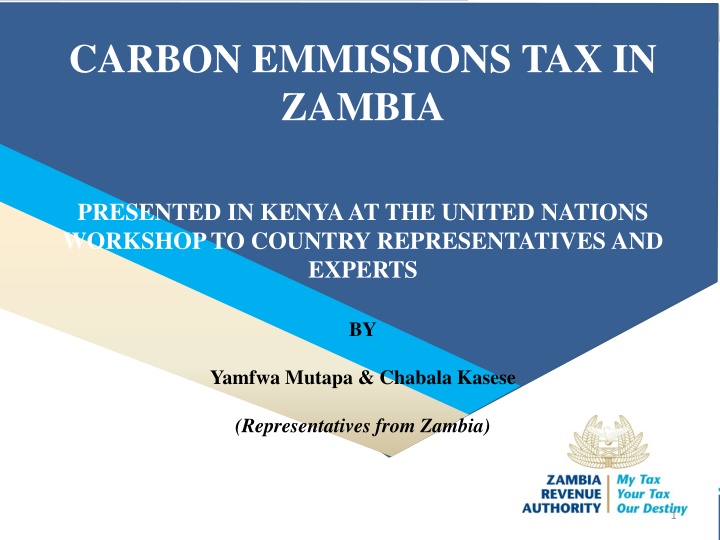
Carbon Emissions Tax in Zambia - Policy Overview and Implementation
This presentation highlights the introduction of a Carbon Emissions Tax in Zambia, focusing on policy considerations, environmental impacts, revenue generation, and challenges faced. It discusses key commitments in environmental policy and steps taken towards implementation. The tax aims to address environmental issues such as greenhouse gases, deforestation, industrial waste, and mining activities in Zambia.
Download Presentation

Please find below an Image/Link to download the presentation.
The content on the website is provided AS IS for your information and personal use only. It may not be sold, licensed, or shared on other websites without obtaining consent from the author. If you encounter any issues during the download, it is possible that the publisher has removed the file from their server.
You are allowed to download the files provided on this website for personal or commercial use, subject to the condition that they are used lawfully. All files are the property of their respective owners.
The content on the website is provided AS IS for your information and personal use only. It may not be sold, licensed, or shared on other websites without obtaining consent from the author.
E N D
Presentation Transcript
CARBON EMMISSIONS TAX IN ZAMBIA PRESENTED IN KENYA AT THE UNITED NATIONS WORKSHOP TO COUNTRY REPRESENTATIVES AND EXPERTS BY Yamfwa Mutapa & Chabala Kasese (Representatives from Zambia) 1 My Tax, Your Tax, Our Destiny My Tax, Your Tax, Our Destiny
PRESENTATION LAYOUT Introduction Emissions Policy Consideration and Introduction of CES -Charging Schedules Environmental Impact of the tax The revenue impact of the tax (amounts collected) The economic impact of the tax for the taxpayers Other issues, including successes and challenges. Steps taken towards implementation of MBIs 2 My Tax, Your Tax, Our Destiny My Tax, Your Tax, Our Destiny
INTRODUCTION Environmental issues in Zambia have been a subject of debate and policy interventions by government throughout the industrial life of the nation. Some of the environmental issues handled by different policies in Zambia include: 1. Green House and non-Green House Gases (Including carbon emissions) 2. Deforestation 3. Industrial waste (emissions, effluents & solid waste) 4. Damage to the environment (land) due to mining activities. 3 My Tax, Your Tax, Our Destiny My Tax, Your Tax, Our Destiny
EMISSIONS Atmospheric emissions are emissions of gas of both greenhouse and non-greenhouse resulting from human activities and natural systems. Sources of emissions include energy consumption, food production, and urban development as well transportation1 In Zambia, these are influenced by population growth, economic activity and poverty in most comunities2( bringing about charcoal burning and cut-and-burn methods of agriculture). 1. Zambia Environmental Outlook Report 4, 2017, page xi 2. Zambia Environmental Outlook Report 4, 2017, page 89 4 My Tax, Your Tax, Our Destiny My Tax, Your Tax, Our Destiny
POLICY CONSIDERATIONS To safeguard the environment, government has been encouraging alternative sources of energy, regulating and controlling waste disposal and implemented deterrent measures to protect the environment (including tax measures e.g. Carbon Emissions Surtax, tax on plastics etc.) Emissions done through means other than transportation are managed and regulated by the Zambia Environmental Management Agency ( ZEMA ). Section 32 of the Environmental Management Act No 12 of 2011 prohibits any emission of a contaminant or pollutant into the environment without a permit. A person who contravenes is liable to imprisonment for 7 years 5 My Tax, Your Tax, Our Destiny My Tax, Your Tax, Our Destiny
KEY COMMITMENTS IN ENVIRONMENTAL POLICY These include: Vision 2030 & 7th National Development plan to exploit and encourage sustainable use of resources National policies on the environment, forestry and agriculture discourage deforestation, encourange environmentally friendly methods of farming. Imposition of Excise Duty (10%, increased to 30% in 2019) on plastic shopping bags in 2013 (SI 16 of 2013), and full ban on the use on non-biodegradable plastic bags in 2019. An additional Surtax of K2000 ($147) per vehicle imposed on vehicles older than 5 years from 2015 (SI 18 of 2015). More strategies and programmes are summarised in the table below: 6 My Tax, Your Tax, Our Destiny My Tax, Your Tax, Our Destiny
PROGRAMMES FOR SUSTAINABLE RESOURCE MANAGEMENT Programme/Plan/Project Objective National Tree Planting Programme (NTPP) - 2013 An initiative aimed at planting 10,000 hectares of plantations countrywide annually. The Land Development Fund (LDF) - 1995 A Fund administered to assist Local Authorities to open up new areas for development. National Biodiversity Strategy and Action Plan, 1999 Improving the legal and institutional framework and human resources to implement the strategies for conservation of sustainable use and equitable sharing of the benefits from biodiversity. Zambia National Action Plan for Combating Desertification, 2002 Sustainable education/control of land degradation environmental management through the Copperbelt Environment Project, 2004 Focused on mitigation of the environmental liabilities of soil and ground water pollution in the mining areas. Integrated Land use Assessment Project (ILUA) 2005 to 2008 improvecapacity in collecting and analyzing forest resource and forest related information for sustainable forest Management, REDD+ monitoring and GHG reporting. UNREDD Programme 2010 to 2013 A national strategy for the development of a forest monitoring system and information gathering on safeguards. 7 My Tax, Your Tax, Our Destiny My Tax, Your Tax, Our Destiny
OTHER KEY POLICY COMMITMENTS Other policies, strategies and plans that address the risks of climate change or environmental protection in different communities include: 1. 2. 3. 4. 5. 6. 7. 8. 9. 10. National Strategy for Reducing Emissions from Deforestation and Forest Degradation (REDD+, 2015) National Policy on Environment (NPE) - 2007 National Adaptation Programme of Action (NAPA)- 2007 National Policy on Climate Change - 2016 Pilot Programme for Climate Resilience (PPCR) - 2013 to 2019 Low Emission Capacity Building Project (LECB) 2011 for 5 years National Climate Change Response Strategy (NCCRS) 2010. National Climate Change Response Strategy 2010 Intended Nationally Determined Contribution (INDC) 2015 National Forestry Policy of 2014 8 My Tax, Your Tax, Our Destiny My Tax, Your Tax, Our Destiny
OTHER KEY POLICY COMMITMENTS In addition, Zambia continues to be party to: The United Nation Convention on Climate Change (UNFCCC), The Convention to Combat Desertification (CCD); and The Convention for Biological Diversity (CBD). 9 My Tax, Your Tax, Our Destiny My Tax, Your Tax, Our Destiny
THE INTRODUCTION OF CARBON SURTAX For emissions that are as a result of transportation, government introduced a tax measure, Carbon Emission Surtax ( CES ) in 2006 in addition to the above stated measures in order to discourage citizens from purchasing vehicles with high carbon dioxide emitting engines. It was also envisaged that the tax collected would help finance programs and/or projects to mitigate the impacts of climate change This was done through Statutory Instrument No. 9 of 20063 Ambulances, prison vans, hearses, vehicles propelled by non-pollutant energy and vehicles for international organisations and diplomatic missions were exempted. 3. The Customs and Excise (General)(Amendment) Regulations, 2006 10 My Tax, Your Tax, Our Destiny My Tax, Your Tax, Our Destiny
THE INTRODUCTION OF CARBON SURTAX Further, the SI stipulated that carbon emission surtax would be due on all vehicles due for renewal of road license - to be collected by the Road Transport and Safety Agency ( RATSA ) . However, this could not be implemented until 2010 due to administrative challenges. From 2010 to date, inland collection of Carbon emission surtax is done by RATSA The charging schedule between 2006 and 2019 is as follows: 11 My Tax, Your Tax, Our Destiny My Tax, Your Tax, Our Destiny
CHARGING SCHEDULE FOR CES 2006 CES Rate 2016 CES Rate 2019 CES Rate Engine Size (cc) ZMW USD ZMW USD ZMW USD Motor Cycles 140 10 1500 and below 50 3.7 70 5.1 140 10 1501 2000 100 7.4 140 10 280 21 2001 3000 150 11 200 15 400 29 3001 and above 200 15 275 20 550 40 Note that the Surtax of K2000 ($147) per vehicle introduced in 2015 on vehicles older than 5 years is separate from Carbon Emissions Surtax. It is dependent on age of vehicle, rather than engine size. 12 My Tax, Your Tax, Our Destiny My Tax, Your Tax, Our Destiny
ENVIRONMENTAL IMPACT From 2006 to 2017, There has been an increase in the number of motor vehicles in use. For instance, the number of motor vehicle increased from 230,332 in 2007 to 663,529 in 20154 However, reports show a reduction in pollution from vehicles in compared to GDPgrowth 5, for instance in 2016 releases from vehicles were considered to be insignificant (ZEMA, 2016) 6 compared to other pollutants like waste incineration, open air burning, and other Persistent Organic Pollutants (POPs) This could be due to the fact that the tax expense has tended to discourage taxpayers from buying of older cars and cars with bigger engines. It can also be attributed to the Surtax on vehicles older that 5 years. 4. Zambia Environmental Outlook Report 4, 2017, page 95 5. USAID on https://www.climatelinks.org/ 6. Zambia Environmental Outlook Report 4, 2017, page 113 13 My Tax, Your Tax, Our Destiny My Tax, Your Tax, Our Destiny
REVENUE IMPACT Year 2006 2007 2008 2009 2010 2011 2012 2013 2014 2015 2016 2017 2018 Target(K'000) Target ($'000) Actual (K'000) Actual ($'000) % Growth in Actual - 2,200 361 6,900 - 7,000 1,611 5,900 2,413 12,117 5,556 17,101 5,893 22,149 7,404 29,456 12,734 49,142 8,692 37,390 8,823 40,794 10,230 64,249 18,070 111,882 - 611 1,917 1,944 1,639 3,366 4,750 6,152 8,182 13,651 10,386 11,332 17,847 31,078 - 1,300 214% 1% -16% 105% 41% 30% 33% 67% -24% 9% 57% 74% - 5,800 8,688 20,000 21,216 26,656 45,842 31,290 31,764 36,828 65,051 NOTES: 1. The significant increase in revenues collected in 2017 and 2018 is attributed to both the change in the rate of tax and the efficiency in the inland collection of the tax after computerisation of the RATSA system 2. These amounts do not include collections for the general surtax on vehicles older than 5 years. 14 My Tax, Your Tax, Our Destiny My Tax, Your Tax, Our Destiny
ECONOMIC IMPACT ON TAXPAYERS From 2006 to date, payment of this tax has increased the cost of owning and maintaining a motor vehicle- especially older vehicles with bigger engine sizes. This has contributed to reduction in emissions. This is more evident from 2017 when there was an improvement in the efficiency of the collection of CES by RATSA after computerisation of the collection. Before then, CES was a stand alone payment at RATSA. But in 2017, it became imbedded in the ZAMTIS (RATSA system) and linked to road tax, meaning the road license for each quarter can no longer be issued without payment of CES for that quarter. 15 My Tax, Your Tax, Our Destiny My Tax, Your Tax, Our Destiny
SUCCESSES The tax is simple and impartial hence the impact has been on the entire driving public. No single class has been over burdened beyond another. Discourages citizens from owning older vehicles with big engine sizes which emit more pollutants. Has contributed to revenue for the nation and availed to government the resources to help fund programs to mitigate the effects of climate change. 16 My Tax, Your Tax, Our Destiny My Tax, Your Tax, Our Destiny
CHALLENGES There has been minimal education of the public by government on the importance and reason for the introduction of the tax This has led to unending complaints from tax payers even as they pay. Before computerisation at RATSA, it even led to some citizens evading payment altogether. Lack of reports on the use of the tax has led to low motivation for compliance. Complexity of managing the tax inland forced ZRA (Zambia Revenue Authority) to ask RATSA to collect on its behalf. Initial lack of administrative capacity by RATSA affected timely full implementation. 17 My Tax, Your Tax, Our Destiny My Tax, Your Tax, Our Destiny
SOME STEPS TOWARDS MBIs Some examples of steps taken in line with implementation of Market Based Incentives are: Introduction of a fee on sinking and using bore holes (for use of underground water resource) Hunting and forestry harvesting requires a license Allowable deduction for restoration & rehabilitation works or amounts paid into the Environmental Protection Fund for mines (an incentive for environmental restoration) Taxes (excise duty of 30% ) on plastic shopping bags Taxes in transport category e.g. road tax, carbon emission surtax, motor vehicle surtax Resource taxes in mining mineral royalty is a form of mineral tax 18 My Tax, Your Tax, Our Destiny My Tax, Your Tax, Our Destiny
THANK YOU 19 My Tax, Your Tax, Our Destiny My Tax, Your Tax, Our Destiny

